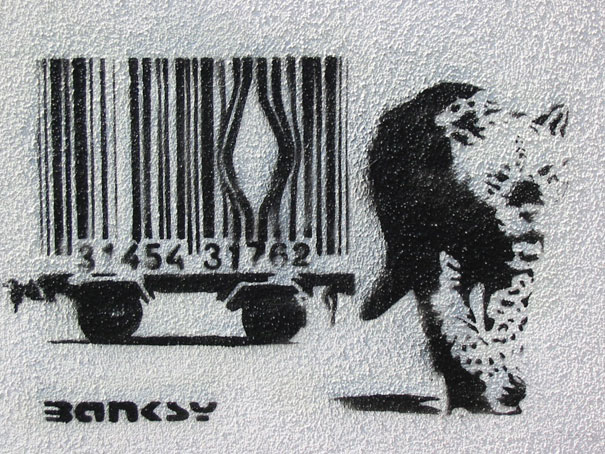According to George Dickie in his Institutional definition for art, the artworld consists of the artist, the work of art itself, and the public which makes up the artworld system. The artworld system is a basis for the presentation of art, by an artist, to the artworld public.[1] The art maker has to make art with the intention of expressing a specific viewpoint or idea and in order for this idea to be considered art, the viewer must be approaching the work with a the correct mindset: they must have the knowledge and willingness to understand the history or context in which the artist is speaking through the use of any one medium. For example, many people are familiar with the works of the artist Banksy[2], but not everyone would consider him a fine artist. Those who do not understand the socio-political content of his works consider him among the many other ‘graffiti artists’ that roams the streets tagging objects with no higher purpose or message to their images.
Consider the Following works by Banksy: Someone who does not know the work of Banksy or understand its political and social implications may just see the image as a reference to art tools or graphics, maybe even simply graffiti stenciled on a wall. The artworld public looks further into the meaning of work by expressing a willingness to know or become aware of recent events, locally and globally, and apply the commentary surrounding those events to the context of the image. For instance, instead of just a pair of scissors and a dotted line, the first image becomes a commentary on what lies beyond the wall separating two social worlds, and the need to create a window for seeing and understanding whatever it is that exists on the other side. Also, the artworld public might discuss the second image as having implications about finding the strength to escape the cage we create for ourselves socially through mass consumerism. It can also be said that this limitation stems from the need to place a value on everything in out natural world.
Cut Out by Banksy, year unknown. Spray Paint [3]

Banksy, Spray Paint, year unknown [4]
Art is inclusive of a specific type of art medium, arranged in a composition which uses design elements to communicate a feeling, and uses those emotions as a vessel to create discourse about an idea. The artist Timo[5] uses the medium of time-lapse photography and a light rod to capture multiple images of otherwise invisible WiFi signals, creating walls of light where WiFi signal is available for users. Timo is laying the foundation for a discussion about things prevalent in our lives which we are less aware of, and maybe even take for granted. In the art community, this type of idea will branch out into multiple wavelengths, expanding upon the artist original ideas, and hopefully creating discourse on those ideas within the artworld public.
Artists like JR[6], winner of the 2011 TED prize, have learned to explore their mediums and involve others in their in order to spread the commentary outward from each work of art. JR has been successful at recognizing universal ideas revealed to him through issues in media and through face to face contact with people who both influence and are influenced by his work. By making public art he is involving people who may not begin as an art public, but through the involvement and impact of his works become part of the artworld public because they come to understand the significance of the messages imbedded in it. The people whom JR photographs will come to understand they are participating in cultural and social commentary. He creates a larger art public by involving his subject matter and allowing them to spread the meaning of the works. Because the works are images from the cultures in which they are displayed, the layers of meaning are gradually peeled back and understood by each individual culture’s public. This ripple of cultural pride and awareness spreads and creates eventually a common ground to connect different cultures together. JR’s work is an example of work that successfully communicates the artist’s ideas and imbeds them in the minds of the viewers.
Art is not just art because it is in the public realm. Art must be critiqued and commented on with the knowledge of both objective and subjective content. A viewer must be able to look at the subject matter and use of formal elements and use those to infer meaning. Furthermore, the viewer must have knowledge on which to base their understanding of the work. While art may be a form of indulgence or fun, when speaking of the Fine Arts, art must be made with the intent of creating discussion and spreading ideas while creating something that is visually interesting.
[1] “Institutional Theory of Art and the Art World,” http://www9.georgetown.edu/faculty/irvinem/visualarts/Institutional-theory-artworld.html (accessed Jan. 15,2012).
[1] http://www.banksy.co.uk/index.html (accessed Jan.15,2012).
[1] ibid
[1] ibid
[1] “Immaterials: Light painting WiFi,” http://vimeo.com/20412632 (accessed Jan. 5,2012).

No comments:
Post a Comment